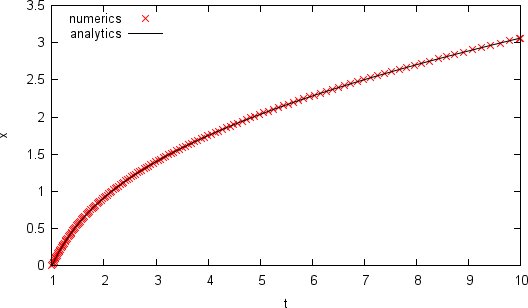Examples
Here you find some short examples showing how quick and easy odeint can be used to implement numerical simulations. For a more detailed description please vist the docs.
- Lorenz System: 30 lines of C++ to generate a trajectory on the Lorenz attractor
- Simple 1D ODE : A small example showing the integration of a simple 1D system.
Lorenz System
30 lines of C++ to generate a trajectory on the Lorenz attractor.
#include <iostream> #include <boost/array.hpp> #include <boost/numeric/odeint.hpp> using namespace std; using namespace boost::numeric::odeint; const double sigma = 10.0; const double R = 28.0; const double b = 8.0 / 3.0; typedef boost::array< double , 3 > state_type; void lorenz( const state_type &x , state_type &dxdt , double t ) { dxdt[0] = sigma * ( x[1] - x[0] ); dxdt[1] = R * x[0] - x[1] - x[0] * x[2]; dxdt[2] = -b * x[2] + x[0] * x[1]; } void write_lorenz( const state_type &x , const double t ) { cout << t << '\t' << x[0] << '\t' << x[1] << '\t' << x[2] << endl; } int main(int argc, char **argv) { state_type x = { 10.0 , 1.0 , 1.0 }; // initial conditions integrate( lorenz , x , 0.0 , 25.0 , 0.1 , write_lorenz ); }

Simple 1D ODE
The following code shows how to obtain the numerical solution of a simple one-dimensional ODE. Note the configuration of the stepper type showing the flexibility of the library.
#include <iostream> #include <boost/numeric/odeint.hpp> using namespace std; using namespace boost::numeric::odeint; /* we solve the simple ODE x' = 3/(2t^2) + x/(2t) * with initial condition x(1) = 0. * Analytic solution is x(t) = sqrt(t) - 1/t */ void rhs( const double x , double &dxdt , const double t ) { dxdt = 3.0/(2.0*t*t) + x/(2.0*t); } void write_cout( const double &x , const double t ) { cout << t << '\t' << x << endl; } // state_type = double typedef runge_kutta_dopri5< double > stepper_type; int main() { double x = 0.0; integrate_adaptive( make_controlled( 1E-12 , 1E-12 , stepper_type() ) , rhs , x , 1.0 , 10.0 , 0.1 , write_cout ); }
